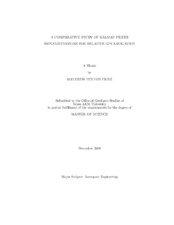| dc.contributor.advisor | Vadali, Srinivas R. | |
| dc.creator | Fritz, Matthew Peyton | |
| dc.date.accessioned | 2011-02-22T22:23:43Z | |
| dc.date.accessioned | 2011-02-22T23:45:25Z | |
| dc.date.available | 2011-02-22T22:23:43Z | |
| dc.date.available | 2011-02-22T23:45:25Z | |
| dc.date.created | 2009-12 | |
| dc.date.issued | 2011-02-22 | |
| dc.date.submitted | December 2009 | |
| dc.identifier.uri | https://hdl.handle.net/1969.1/ETD-TAMU-2009-12-7338 | |
| dc.description.abstract | Relative global positioning system (GPS) navigation is currently used for autonomous
rendezvous and docking of two spacecraft as well as formation
flying applications.
GPS receivers deliver measurements to
flight software that use this information
to determine estimates of the current states of the spacecraft. The success
of autonomous proximity operations in the presence of an uncertain environment
and noisy measurements depends primarily on the navigation accuracy. This thesis
presents the implementation and calibration of a spaceborne GPS receiver model, a
visibility analysis for multiple GPS antenna cone angles, the implementation of four
different extended Kalman filter architectures and a comparison of the advantages
and disadvantages of each filter used for relative GPS navigation. A spaceborne GPS
model is developed to generate simulated GPS measurements for a spacecraft located
on any orbit around the Earth below the GPS constellation. Position and velocity
estimation algorithms for GPS receivers are developed and implemented. A visibility
analysis is performed to determine the number of visible satellites throughout the
duration of the rendezvous. Multiple constant fields of view are analyzed and results
compared to develop an understanding of how the GPS constellation evolves during
the proximity operations. The comparison is used to choose a field of view with adequate
satellite coverage. The advantages and disadvantages of the relative navigation
architectures are evaluated based on a trade study involving several parameters.
It is determined in this thesis that a reduced pseudorange filter provides the best overall performance in both relative and absolute navigation with less computational
cost than the slightly more accurate pseudorange lter. A relative pseudorange architecture
experiences complications due to multipath rich environments and performs
well in only relative navigation. A position velocity architecture performs well in
absolute state estimation but the worst of the four filters studied in relative state
estimation. | en |
| dc.format.mimetype | application/pdf | |
| dc.language.iso | en_US | |
| dc.subject | GPS | en |
| dc.subject | Development of GPS sensor model for orbiting spacecraft | en |
| dc.subject | Navigation | en |
| dc.subject | Study of different Kalman architectures for relative GPS navigation | en |
| dc.subject | Comparison | en |
| dc.subject | Comparison of four Kalman filters to determine advantages and disadvantages of each for relative GPS navigation | en |
| dc.title | A Comparative Study of Kalman Filter Implementations for Relative GPS Navigation | en |
| dc.type | Thesis | en |
| thesis.degree.department | Aerospace Engineering | en |
| thesis.degree.discipline | Aerospace Engineering | en |
| thesis.degree.grantor | Texas A&M University | en |
| thesis.degree.name | Master of Science | en |
| thesis.degree.level | Masters | en |
| dc.contributor.committeeMember | Kalmar-Nagy, Tamas | |
| dc.contributor.committeeMember | Datta, Aniruddha | |
| dc.contributor.committeeMember | Zanetti, Renato | |
| dc.type.genre | thesis | en |
| dc.type.material | text | en |


